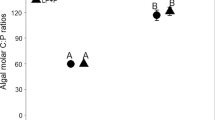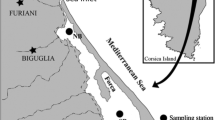Abstract
With respect to nutrients, plants are rather non-homoeostatic while most metazoans have much more confined ranges of nutrient ratios. It was recently highlighted that the homoeostatic ability of microzooplankters lies in between these two extremes. Nevertheless, we know very little on the dynamics of stoichiometric changes. Hence, we investigated how the stoichiometry of the heterotrophic dinoflagellate Oxyrrhis marina is affected (1) during a starvation period and (2) when fed nutrient deplete Rhodomonas salina after having been pre-conditioned on nutrient replete algae and vice versa. We observed that the dinoflagellate was able to maintain its N:P ratio constant over 78 h of starvation. We inferred that under starvation, nitrogen-limited O. marina mainly used fat as energy source while nitrogen-rich individuals also used proteins as fuel in cellular respiration. Further, we showed that O. marina presents resistance to nutrient limitation, with stronger regulation against P-limitation than against N-limitation. This resilience in microzooplankton stoichiometry following food quality stress would have great implications for both top-down (nutrient remineralisation) and bottom-up controls (quality as food).




Similar content being viewed by others
References
Andersen T, Hessen DO (1991) Carbon, nitrogen, and phosphorus content of freshwater zooplankton. Limnol Oceanogr 36:807–814
Bossuyt BTA, Janssen CR (2005) Copper regulation and homeostasis of Daphnia magna and Pseudokirchneriella subcapitata: influence of acclimation. Environ Pollut 136:135–144
Cushing DH (1989) A difference in structure between ecosystems in strongly stratified waters and in those that are only weakly stratified. J Plankton Res 11:1–13
DeMott WR, Pape BJ (2005) Stoichiometry in an ecological context: testing for links between Daphnia P-content, growth rate and habitat preference. Oecologia 142:20–27
Droop MR (1973) Nutrient limitation in Osmotrophic Protista. Am Zool 13:209–214
Elser JJ, Goff NC, MacKay NA, Amand ALS, Elser MM, Carpenter SR (1987) Species-specific algal responses to zooplankton: experimental and field observations in three nutrient-limited lakes. J Plankton Res 9:699–717
Elser JJ, Dobberfuhl DR, MacKay NA, Schampel JH (1996) Organism size, life history, and N:P stoichiometry. Bioscience 46:674–684
Flynn KJ, Davidson K (1993) Predator-prey interactions between Isochrysis galbana and Oxyrrhis marina. II. Release of non-protein amines and faeces during predation of Isochrysis. J Plankton Res 15:893–905
Gaines G, Taylor FJR (1984) Extracellular digestion in marine dinoflagellates. J Plankton Res 6:1057–1061
Gasparini S, Daro MH, Antajan E, Tackx M, Rousseau V, Parent JY, Lancelot C (2000) Mesozooplankton grazing during the Phaeocystis globosa bloom in the southern bight of the North Sea. J Sea Res 43:345–356
Gatti S, Brey T, Müller WEG, Heilmayer O, Holst G (2002) Oxygen microoptodes: a new tool for oxygen measurements in aquatic animal ecology. Mar Biol 140:1075–1085
Grasshoff K, Ehrhardt M, Kremling K (1999) Methods of seawater analysis. Wiley-VCH, Weinheim
Grover JP, Chrzanowski TH (2006) Stoichiometry and growth kinetics in the “smallest zooplankton”—phagotrophic flagellates. Arch Hydrobiol 167:467–487
Guillard RRL, Ryther JH (1962) Studies of marine planktonic diatoms. I. Cyclotella nana Hustedt and Detonula confervacea Cleve. Can J Microbiol 8:229–239
Hantzsche FM, Boersma M (2010) Dietary-induced responses in the phagotrophic flagellate Oxyrrhis marina. Mar Biol 157:1641–1651
Hessen DO (1990) Carbon, nitrogen and phosphorus status in Daphnia at varying food conditions. J Plankton Res 12:1239–1249
Hillebrand H, Sommer U (1999) The Nutrient Stoichiometry of Benthic Microalgal Growth: redfield Proportions are Optimal. Limnol Oceanogr 44:440–446
Jeong HJ, Seong KA, Yoo YD, Kim TH, Kang NS, Kim S, Park JY, Kim JS, Kim GH, Song JY (2008) Feeding and grazing impact by small marine heterotrophic dinoflagellates on heterotrophic bacteria. J Eukaryotic Microbiol 55:271–288
Johansson M, Gorokhova E, Larsson U (2004) Annual variability in ciliate community structure, potential prey and predators in the open northern Baltic Sea proper. J Plankton Res 26:67–80
Kimmance SA, Atkinson D, Montagnes DJS (2006) Do temperature–food interactions matter? Responses of production and its components in the model heterotrophic flagellate Oxyrrhis marina. Aquat Microb Ecol 42:63–73
Klausmeier CA, Litchman E, Daufresne T, Levin SA (2004) Optimal nitrogen-to-phosphorus stoichiometry of phytoplankton. Nature 429:171–174
Klein Breteler WCM, Schogt N, Baas M, Schouten S, Kraay GW (1999) Trophic upgrading of food quality by protozoans enhancing copepod growth: role of essential lipids. Mar Biol 135:191–198
Kleppel GS (1993) On the diets of calanoid copepods. Mar Ecol Prog Ser 99:1–2
Landry MR, Calbet A (2004) Significance of predation by protists in aquatic microbial food webs. J Mar Sci 61:501–507
Laspoumaderes C, Modenutti B, Balseiro E (2010) Herbivory versus omnivory: linking homeostasis and elemental imbalance in copepod development. J Plankton Res 32:1573–1582
Levinsen H, Turner JT, Nielsen TG, Hansen BW (2000) On the trophic coupling between protists and copepods in arctic marine ecosystems. Mar Ecol Prog Ser 204:65–77
Löder MGJ, Meunier C, Wiltshire KH, Boersma M, Aberle N (2011) The role of ciliates, heterotrophic dinoflagellates and copepods in structuring spring plankton communities at Helgoland Roads, North Sea. Mar Biol 158:1551–1580
Lowe CD, Martin LE, Roberts EC (2010) Collection, isolation, and culturing strategies for the maintenance of Oxyrrhis marina. J Plankton Res 33:569–578
Lusk G (1924) Animal calorimetry. J Biol Chem 59:41–42
Malzahn AM, Hantzsche F, Schoo KL, Boersma M, Aberle N (2010) Differential effects of nutrient-limited primary production on primary, secondary or tertiary consumers. Oecologia 162:35–48
Martel CM (2010) Regenerated extracellular NH4 + affects the motile chemosensory responses of batchcultured Oxyrrhis marina. Braz J Microbiol 41:321–328
Meunier CL, Hantzsche FM, Cunha-Dupont AÖ, Haafke J, Oppermann B, Malzahn AM, Boersma M (2012) Intraspecific selectivity, compensatory feeding, and flexible homeostasis in the phagotrophic flagellate Oxyrrhis marina: three ways to handle food quality fluctuations. Hydrobiologia 680:53–62
Persson J, Fink P, Goto A, Hood JM, Jonas J, Kato S (2010) To be or not to be what you eat: regulation of stoichiometric homeostasis among autotrophs and heterotrophs. Oikos 119:741–751
Quigg A, Finkel ZV, Irwin AJ, Rosenthal Y, Ho T-Y, Reinfelder JR, Schofield O, Morel FMM, Falkowski PG (2003) The evolutionary inheritance of elemental stoichiometry in marine phytoplankton. Nature 425:291–294
Reche I, Carrillo P, Cruz-Pizarro L (1997) Influence of metazooplankton on interactions of bacteria and phytoplankton in an oligotrophic lake. J Plankton Res 19:631–646
Roberts EC, Wootton EC, Davidson K, Jeong HJ, Lowe CD, Montagnes DJS (2011) Feeding in the dinoflagellate Oxyrrhis marina: linking behaviour with mechanisms. J Plankton Res 33:603–614
Sakami W, Harrington H (1963) Amino acid metabolism. Annu Rev Biochem 32:355–398
Schumann R, Munzert B, Wünsch J-U, Spittler H-P (1994) The feeding biology of Oxyrrhis marina Dujardin (Flagellata). Limnologica 24:29–34
Sherr EB, Sherr BF (2002) Significance of predation by protists in aquatic microbial food webs. Antonie Van Leeuwenhoek 81:293–308
Sommer U (1984) The paradox of the plankton: fluctuations of phosphorus availability maintain diversity of phytoplankton in flow-through cultures. Limnol Oceanogr 29:633–636
Sommer U (1985) Comparison between steady state and non-steady state competition: experiments with natural phytoplankton. Limnol Oceanogr 30:335–346
Sommer U, Sommer F (2006) Cladocerans versus copepods: the cause of contrasting top–down controls on freshwater and marine phytoplankton. Oecologia 147:183–194
Sommer U, Hansen T, Blum O, Holzner N, Vadstein O, Stibor H (2005) Copepod and microzooplankton grazing in mesocosms fertilised with different Si:N ratios: no overlap between food spectra and Si:N influence on zooplankton trophic level. Oecologia 142:274–283
Sterner RW (1990) The ratio of nitrogen to phosphorus resupplied by herbivores: zooplankton and the algal competitive arena. Am Nat 136:209–229
Sterner RW, Elser JJ (2002) Ecological stoichiometry: the biology of elements from molecules to the biosphere. Princeton university press, Princeton and Oxford
Sterner RW, Schwalbach MS (2001) Diel Integration of food quality by Daphnia: luxury consumption by a freshwater planktonic herbivore. Limnol Oceanogr 46:410–416
Tian X, Qin JG (2004) Effects of previous ration restriction on compensatory growth in barramundi Lates calcarifer. Aquaculture 235:273–283
Urzúa Á, Anger K (2011) Larval biomass and chemical composition at hatching in two geographically isolated clades of the shrimp Macrobrachium amazonicum: intra- or interspecific variation? Invertebr Reprod Dev 55:236–246
Weir JBDV (1949) New methods for calculating metabolic rate with special reference to protein metabolism. J Physiol 109:1–9
Wiadnyana N, Rassoulzadegan F (1989) Selective feeding of Acartia clausi and Centropages typicus on microzooplankton. Mar Ecol Prog Ser 53:37–45
Acknowledgments
This study is a part of the PhD study conducted by C.L.M. at the Biologische Anstalt Helgoland, Alfred-Wegener-Institut Bremerhaven, Germany, financed by the Deutsche Forschungsgemeinschaft (DFG, grant MA 4501/1-1) and complies with current German laws and regulations on animal studies. We thank Stefanie Schnell for her help measuring respiration rates of O. marina.
Author information
Authors and Affiliations
Corresponding author
Additional information
Communicated by U. Sommer.
Rights and permissions
About this article
Cite this article
Meunier, C.L., Haafke, J., Oppermann, B. et al. Dynamic stoichiometric response to food quality fluctuations in the heterotrophic dinoflagellate Oxyrrhis marina . Mar Biol 159, 2241–2248 (2012). https://doi.org/10.1007/s00227-012-2009-3
Received:
Accepted:
Published:
Issue Date:
DOI: https://doi.org/10.1007/s00227-012-2009-3




